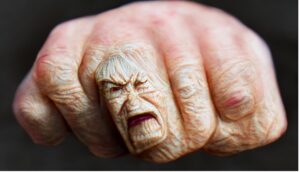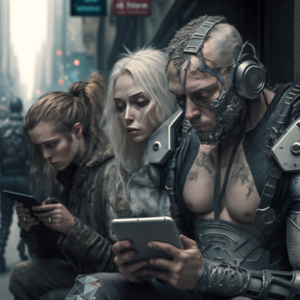Some months ago I found myself down a rabbit hole, drawn into a technological wonderland. Like many around the world, I discovered the apparently limitless possibilities of AI-generated imagery — technology now hitting the mainstream in the form of DALL-E 2, Stable Diffusion, and Midjourney.
Midjourney galleries show users constructing entire graphic novels; Twitter threads extol Stable Diffusion’s ground-breaking developments, from photorealistic video to architectural drawings and images.
In my own work, I have shifted from sourcing stock imagery to generating my own graphics. My specialty, for a time, was producing photorealistic images of different dog breeds wearing a variety of historical and futuristic armour.
In layperson’s terms — and I’m a layman who has run this explanation past several intelligent friends with technological expertise — these tools scrape up visual components of billions of images from all over the web, with any descriptive text that goes with them, then fling them together into a digital cauldron that pumps out something that simultaneously feels like both witchcraft and a mind-blowing technological revolution. We teach these machines the components of an image, and then they put the mutation into permutation, generating billions of never-seen-before images, with varying degrees of success. Sometimes the dogs have six eyes, while other times they look ready to lead a squadron of schnauzers into a medieval war.

My dad asked me if I could make him an image of a grandmother waving an angry hand and it gave me this…

Since then, Midjourney’s image generation has taken stunning leaps forward, so abstract or imaginative cues produce some pretty exceptional results. Warrior schnauzers now look like this without much finicking or fine-tuning of results.

Using or Being Used?
The technology is constantly improving as programmers incorporate more data and make tweaks to their code. Algorithms are dependent on human behaviour in the form of the data we input. But as these technologies become embedded in our practices, they in turn shape human behaviour.
We may think of our relationship to social media algorithms as symbiotic, but in fact it looks increasingly parasitic. Studies have found tools that promise connection with other humans have contributed to spikes in loneliness and anxiety.
One writer, David Courtwright, coined the term “limbic capitalism” to describe how such technology interacts with our brain chemistry to addict us in pursuit of profit. Another, Kevin Roose, warns of “machine drift,” where we hand more and more of our decision-making over to processes created and guided by technology platforms without recognising their goals or impact on our lives.
On the other side of the coin, the history of AI technology is littered with examples of machines reflecting the darker aspects of the human heart.
In 2016, Microsoft released a short-lived AI chatbot named Tay. Tay learned human conversation based on interactions with Twitter users, and within 16 hours, was posting racist tweets and denying the Holocaust. These programmed intelligences take on the likeness of their users, learning what we want from what we give them. They become images — and image makers — that reflect the likeness of their image-making creators.
From Platforms to Pornography
All this has me wondering about the way image-generation technology will impact our brains, our bodies, and our behaviour. How might these technologies revolutionise pornography? And would such a revolution be hopeful or harmful to humans?
Of course, some safeguards have been set up precisely to prevent this possibility. Midjourney has a stringent blacklist of words and terms that cannot be used in generating images, and a Code of Conduct that includes “Don’t use our tools to make images that could inflame, upset, or cause drama. That includes gore and adult content.”
However, these guardrails are already being removed. Web apps already exist that deploy the technology without blacklists, specifically geared towards the algorithmic creation of pornography. Users can now let their imaginations run wild, confident that no human will be (re-)harmed in the realisation of their fantasies – that is, unless the process of imagining and viewing this imagery itself is harmful to the user, especially if the machines aren’t limited by what it is physically possible for human bodies to bear.
To understand the ethics of AI-generated imagery, we need to understand how it works. When a machine composes an image of a human body, it is splicing together body pieces — at the level of a pixel — from a pool of billions of images. These images are scraped from the internet, often with no way for the humans involved in the production of those images to consent to this process (some companies are actively working on paying royalties to artists whose works are swept up in the process).
More images and more hours of video are uploaded to the web daily than any human could view in a lifetime. No human user — or content moderation team — can process all these images, and many of them will never even be looked at by a human. They will, however, be scraped up into the cauldron of images processed and ‘learned’ by these machines, and who could complain about just one or two pixels being sheared off their digital image and attached to pixels from some body elsewhere?
The Body as an Object
In her essay “On Photography”, the philosopher Susan Sontag argued that “there is an aggression implicit in every use of the camera”. By forcefully moulding individuals into an ideal image, “photographers are always imposing standards on their subjects”. The gaze of the camera is not neutral but objectifying. It shapes not just the subject of the image but those who view it, affecting their imaginations at the moment of encounter.
This function of our imagery — and especially the “male gaze” and its implications for women — has been the subject of more recent explorations around the relationship between the imagery of bodies and life in the body. This conversation has stressed that pornography’s influence on our gazes extends beyond the industry and into broader society: men come to view women as objects and place particular expectations on them.
Today we’ve reached a stage where humans desiring a body-as-object can get one on demand. What’s more, this image is not composed by a human photographer but spun up by a machine uninhibited by human moral qualms. What happens to us in this situation? How might these images teach us to see human bodies in the flesh?
Empire of Illusion, a book by Pulitzer-Prize-winning journalist and author Christopher Hedges, documents the devastating impact of digital imagery, in the age of the spectacle, on our individual and collective lives.
Hedges immersed himself in the production side of modern pornography, observing the physical impact that performing for the camera, the objectifying male gaze, and an increasingly violent and degraded set of expectations has on female bodies. Hedges concluded that pornography “is about reducing other human beings to commodities, to objects … It extinguishes the sacred and the human to worship power, control, force, and pain. It replaces empathy and compassion with the illusion that we are gods.”
One might argue, on the basis of the harm this industry does to objectified human bodies, that a seemingly limitless production line of digital imagery built on that historic human sacrifice is morally better than the system continuing to generate new imagery. In other words, “recycled” AI porn is less harmful than the relentless production of fresh non-AI porn. And yet these technologies are drawing on existing images, dismembering images of humans and cobbling them together as a sort of digital Frankenstein’s monster without any thought to the origin of the body parts, or compensating the humans involved in the transaction.
The ethical question must also include asking what consuming this imagery does to us, and how we see and interact with human bodies in meatspace.
Image Bearers
There’s an idea — an ancient one codified in myths, stories, religious frameworks, and even laws — that we are profoundly shaped by the images we consume. The creation and prohibition of idol statues through history recognised that imagery helps create ideals that drive us. Such images are profoundly connected to not only worship — shaping our conception of what we love — but to how we shape ourselves and interact with the world.
The Western world has been indelibly shaped, through Christianity, by the Scriptures of ancient Israel, which open with the claim that we humans are ourselves a sacred image — that we bear the image of God in the world. In the ancient Near Eastern context, this story, along with a law code that prohibited making and worshipping images of God or other gods (the first two of the ten commandments), and laws specifically prohibiting making images of other humans (Deuteronomy 4:16), was subversively distinct.
These stories and laws do something profound: they prevent us creating idealised versions of others — whether God or other humans — leaving us dealing with what is real, and inviting us to treat humans, and human bodies, as inherently sacred. Israel did not need statues of God, because God was represented in your human neighbours, especially as you lived lives together expressing his character. Humans weren’t being asked to measure up against a standard composed in the imagination of the powerful, or projected by the elite.
This contrasted starkly with surrounding nations, all the way up to the Roman Empire, where images of kings and queens would be carved and sent throughout an empire to prop up the ideals, even fashions, of the regime.
Images out of Babylon
One of Israel’s closest neighbours, Babylon, had an entirely different creation story.
In Babylon the king was the divine image, and other humans — and their bodies — only had the dignity given to them by the king. Kings would use their power to build harems of beautiful women, who existed for the pleasure of the divine image. These harems would be guarded by captured slaves or eunuchs. These young men were captured from foreign nations, chosen for their physical beauty, and then had their bodies dismembered as a testimony to the empire’s power.
Scholars suggest Israel’s creation story emerges in conversation with — even as a polemic against — the Babylonian creation mythology, including the Enuma Elish. That narrative begins with the violent god Marduk creating the earth from the dismembered body parts of gods slaughtered in a cosmic war. How the Babylonian king treated human bodies was a reflection of this story.
The porn industry is Babylon.
Consumers act like Babylonian kings collecting a digital harem, turning women from around the world into objects of their fantasy as an expression of dominion. The violence inherent in the production of pornography and the degradation of women constructs what Hedges calls the “dehumanising machine”. He writes:
“Porn reflects back the cruelty of a culture that tosses its mentally ill out on the street, warehouses more than 2 million people in prisons, denies health care to tens of millions of the poor, champions gun ownership over gun control, and trumpets an obnoxious and superpatriotic nationalism and rapacious corporate capitalism. The violence, cruelty, and degradation of porn are expressions of a society that has lost the capacity for empathy.”
The cruelty of traditional pornography has inherent limits: whatever empathy the producer may retain, and the physical limitations of the human body. Yet images (and eventually videos) produced by a machine cobbling together dismembered digital body parts from already objectified human images will face no such limits.
One wonders what impact consuming an unlimited stream of these images — driven by algorithms that fine-tune their results to better match our twisted fantasies — will do to us, especially if we justify our consumption with the empathy-busting notion that these are not real people so it doesn’t matter.
How will such consumption of images dispose us to interact with our human neighbours in meatspace? Will we become more Babylonian, treating others as some profane object to be used? Or will we be inclined to see our neighbour as the sacred which has been embodied?
The Feedback Effect
Literature both ancient and modern poses questions about what consuming or worshipping images does to us.
Narcissus fell so in love with the beauty of his own reflection in a pool that he died, consumed. Characters in David Foster Wallace’s Infinite Jest, when confronted with the perfect piece of image-based entertainment, are so enraptured and ensnared by this vision that they consume it on an infinite loop until they, too, expire.
And there are the Psalms in the Old Testament, a book of poetry that warns of the impact of giving ourselves to images that are not real, to idols. Its warning is clear: we become what we behold (Psalm 115). Those who worship dead images carved in stone (or painted, or pixelated) become like what we worship. We bear the image of the images that shape our imaginations – or as media ecologist Father John Culkin once said: “We shape our tools, and thereafter they shape us.”
AI-generated pornography has the capacity to be utterly dehumanising to those who consume it — and to enhance our capacity to dehumanise others.
As we teach these machines to view human image bearers and their bodies as degraded sexual objects, they, in turn, will transform us into degraded sexual objects for one another.
Does all this mean I should swear off Midjourney and other AI-generated imagery? There are, of course, uses for this new technology that are innocent, and even good. But as media ecologist Marshall McLuhan once said, when we say of new technologies or media “it is how they are used that counts”, this “is the numb stance of the technological idiot”. Some care in embracing new technology is required.
Personally, I’m fascinated by its implications and applications, but I’m terrified by not just its potential in pornography, but its ability to present imagery to us representing an ideal that perfectly matches our desires. The novelist George Eliot once explained the danger of the “clever novelist” creating a perfect world full of perfect humans; she was concerned that if we only encounter perfect humans in our imaginations we “turn a colder eye” on the “real breathing men and women” who we can then harm in our interactions.
What will happen if the machine becomes so good at serving up perfect images to us that we compare all our fellow humans to those machine images, rather than seeing them as images of God? What will prevent us giving ourselves to those images like characters in Infinite Jest, or becoming like Babylonian rulers who seek to impose our wills on the flesh of other humans?
What would it look like to live in (for example) a “dystopian future where a crowd of humans are staring at screens because they have become addicted to AI generated imagery that perfectly mirrors their desires. The natural world is decaying and machines are taking over. Humans can no longer interact with one another because their bodies are no longer as compelling as the on-screen images”? Here’s Midjourney’s imagination of that future, when I composed the above description as a prompt.

Maybe we can imagine a better future than the machine, before we find ourselves too far down the rabbit hole and realise we’re not going to Wonderland.
Nathan Campbell is a Presbyterian pastor in inner-city Brisbane and an Associate of the Centre for Public Christianity.
Cover image was created using Midjourney technology. Credit to Csekk István.


